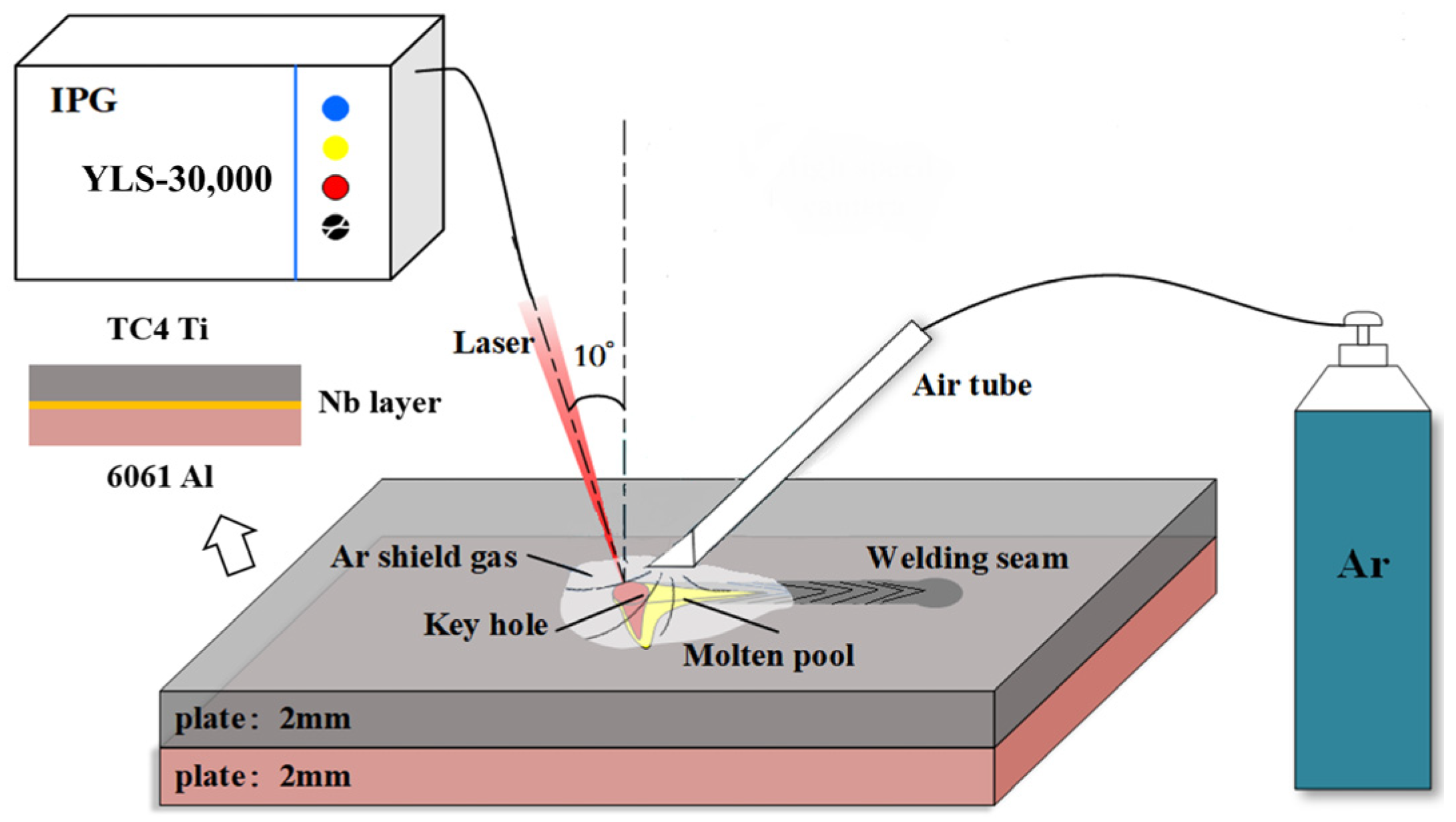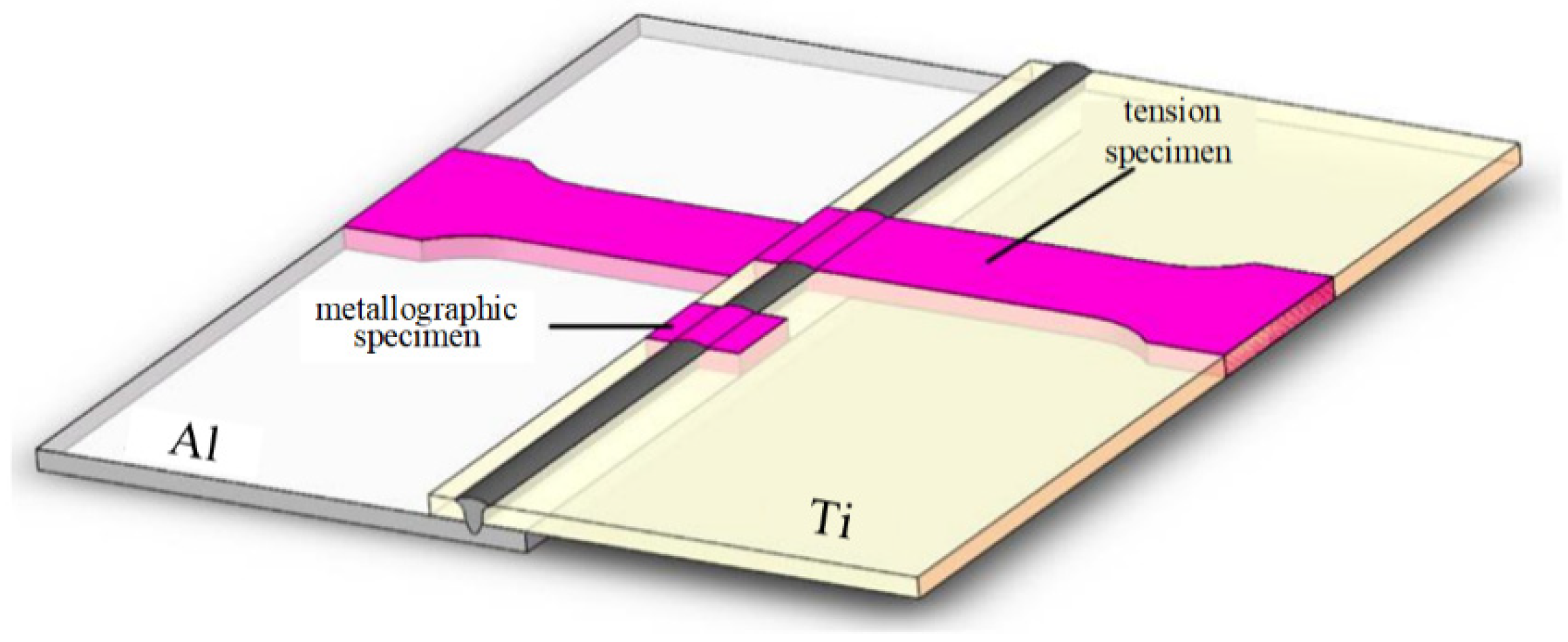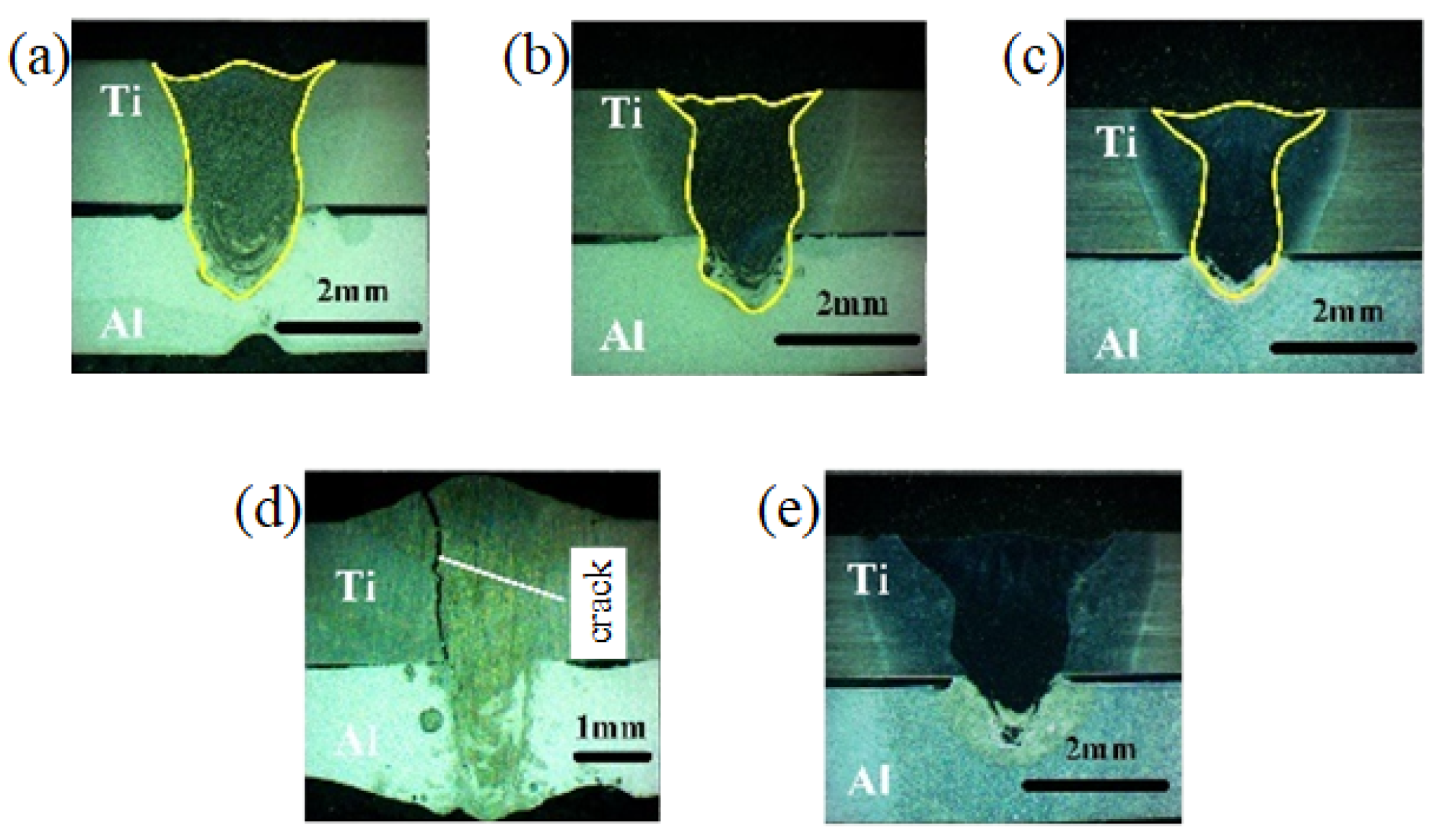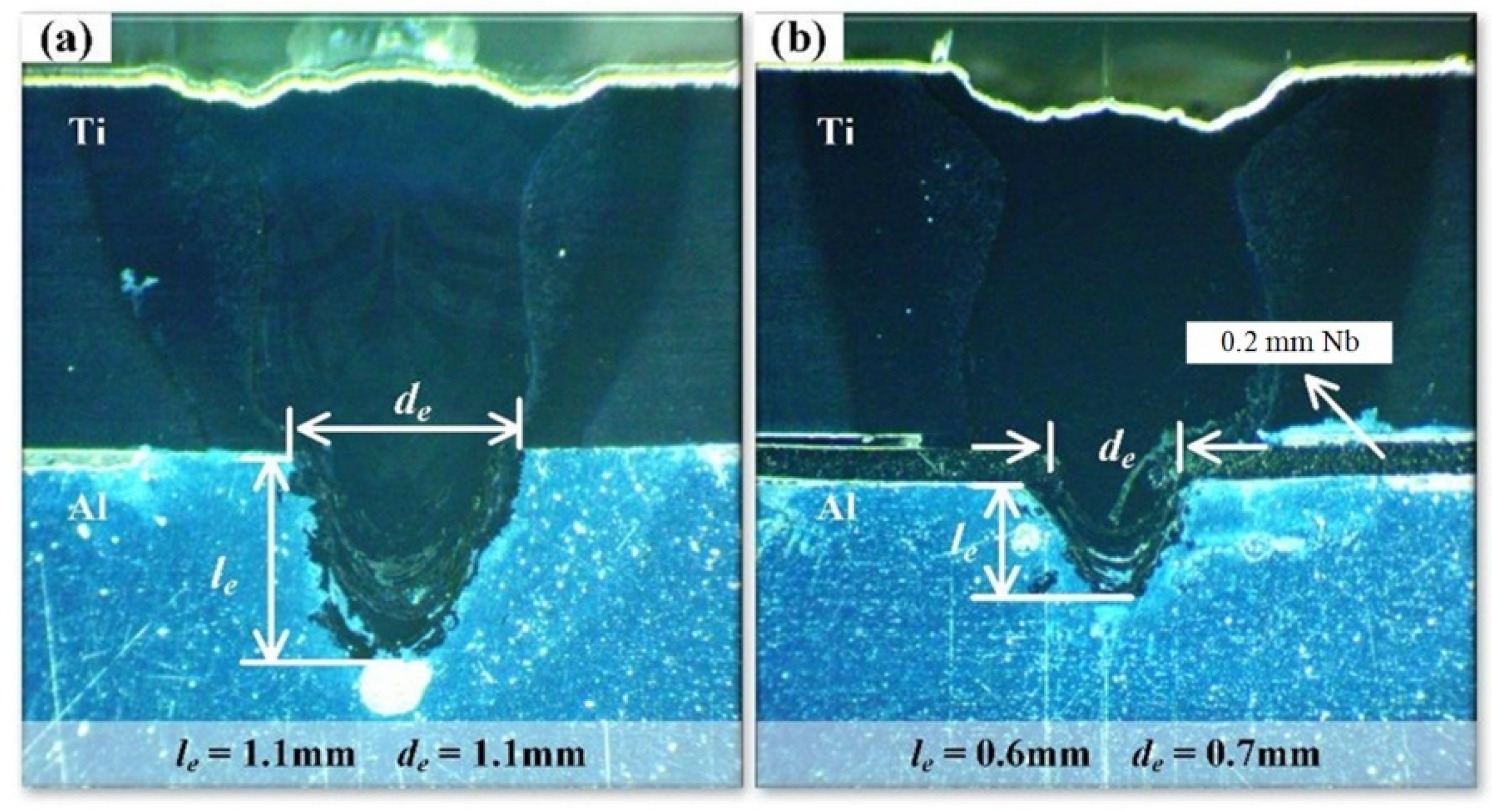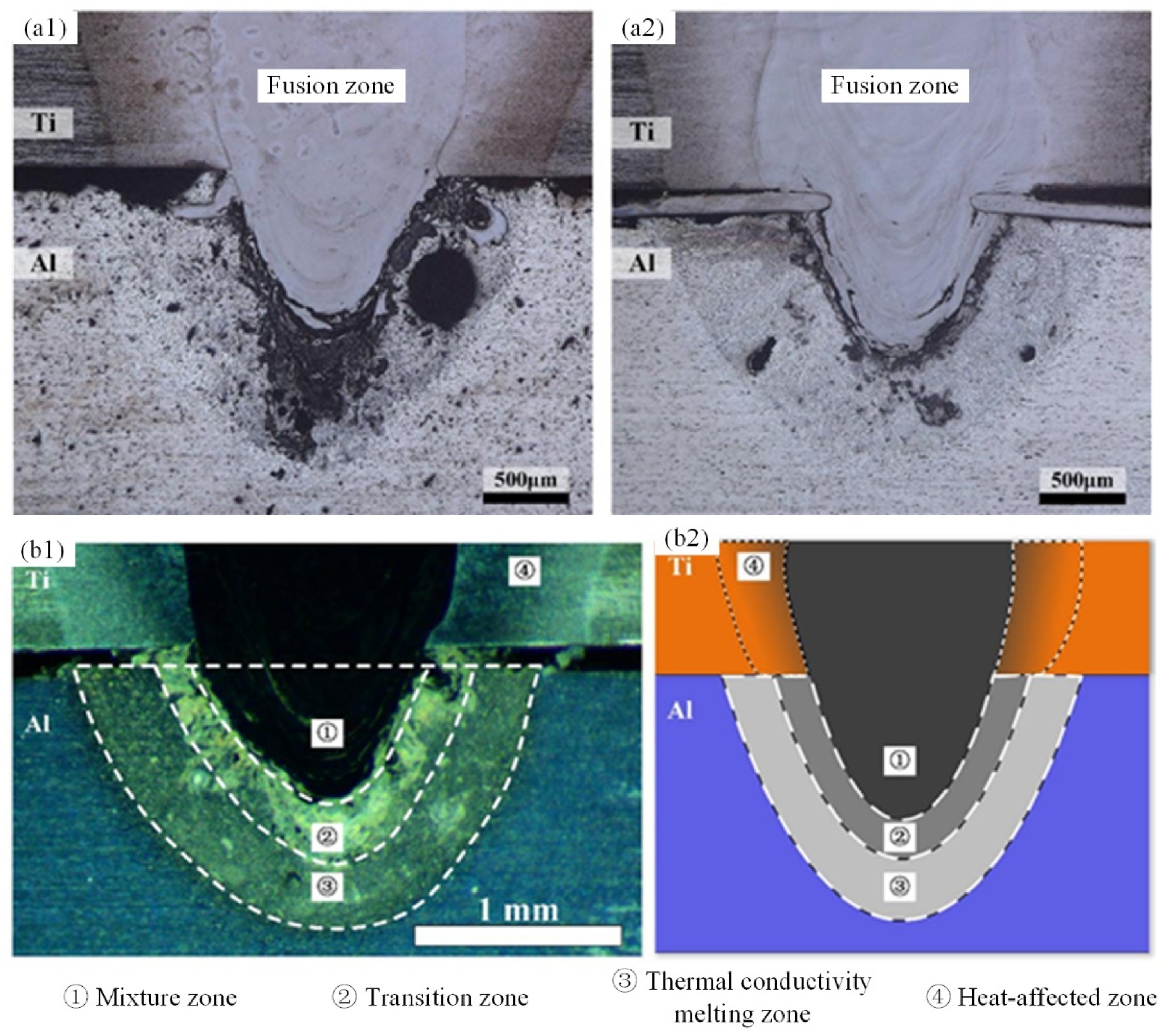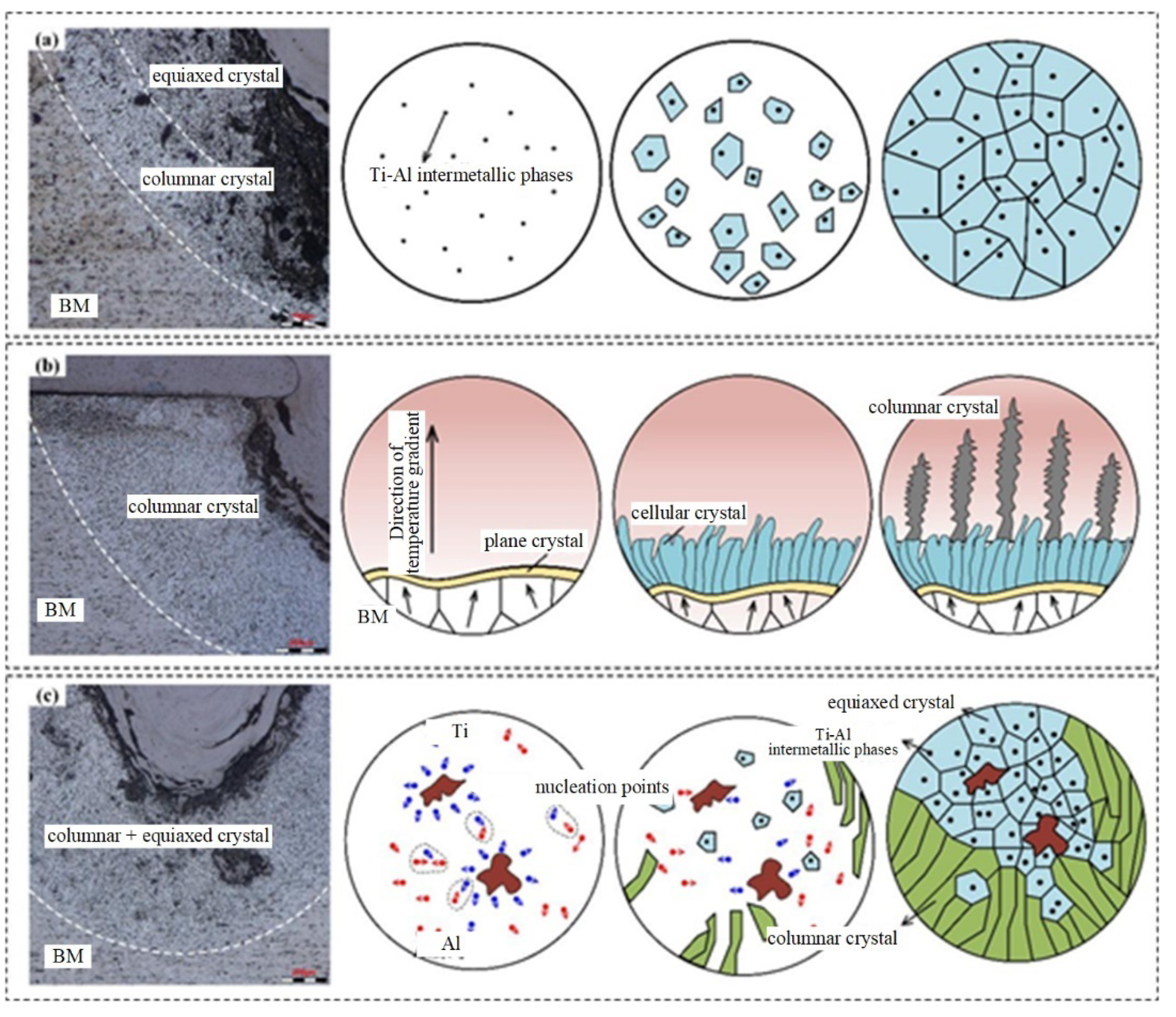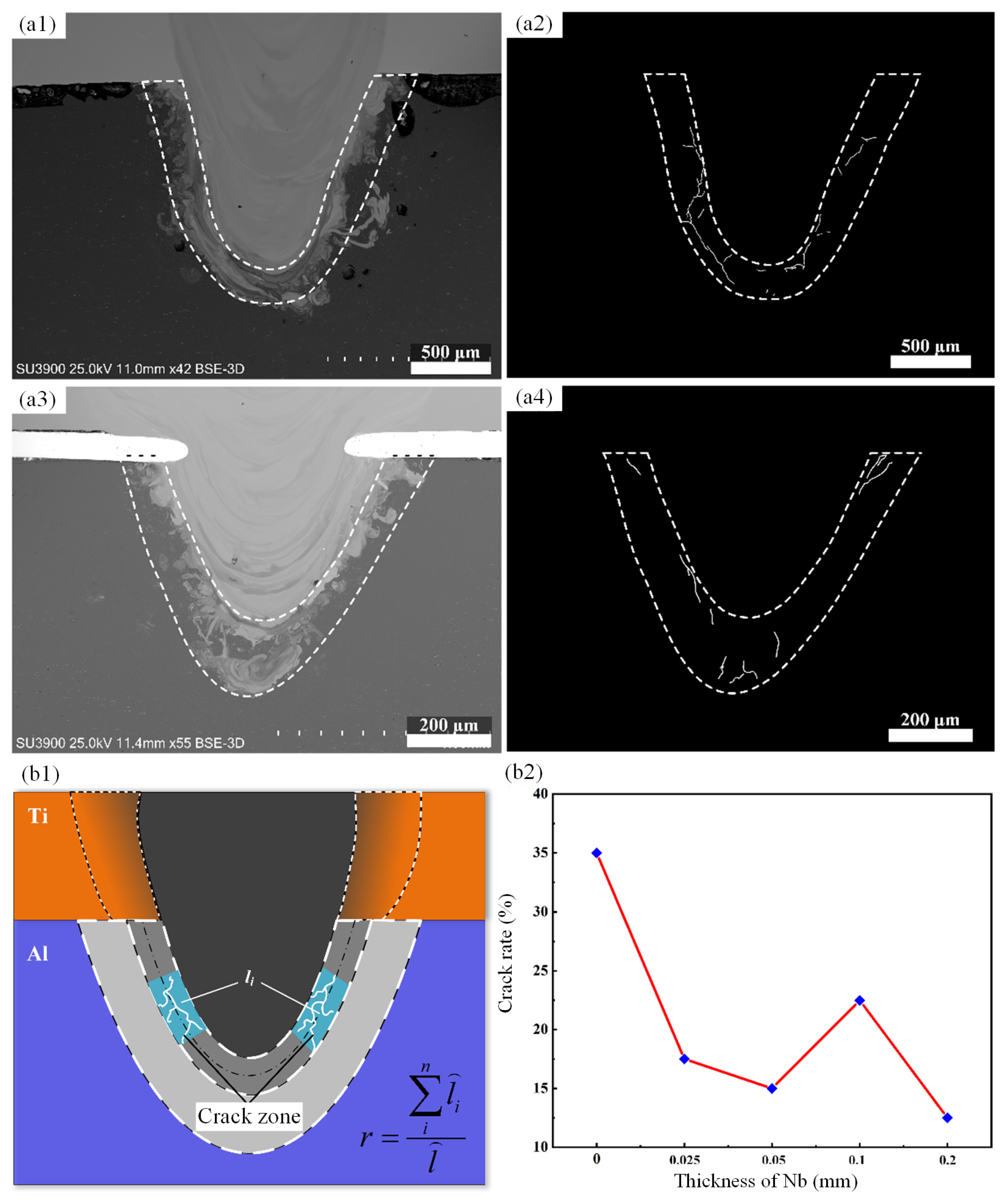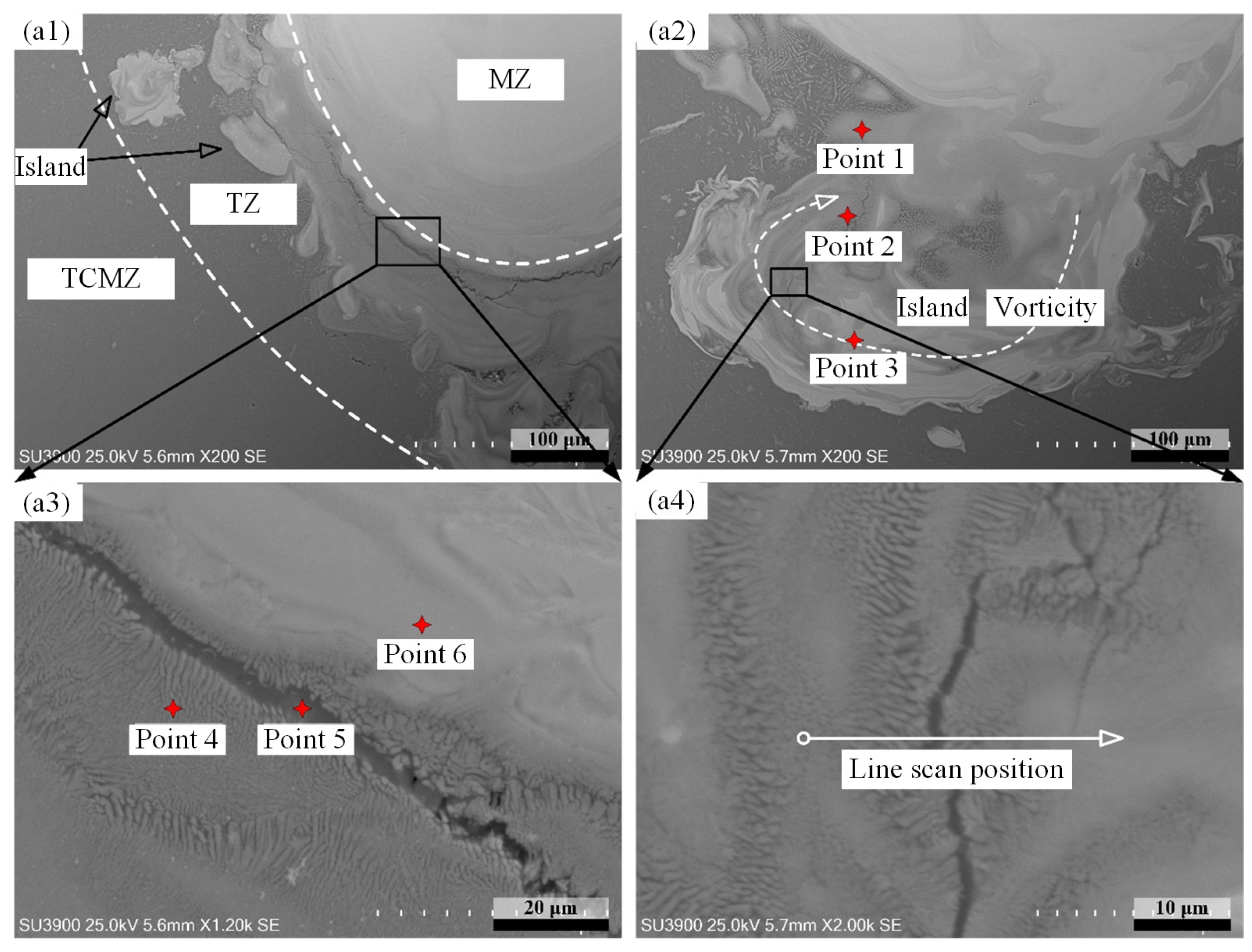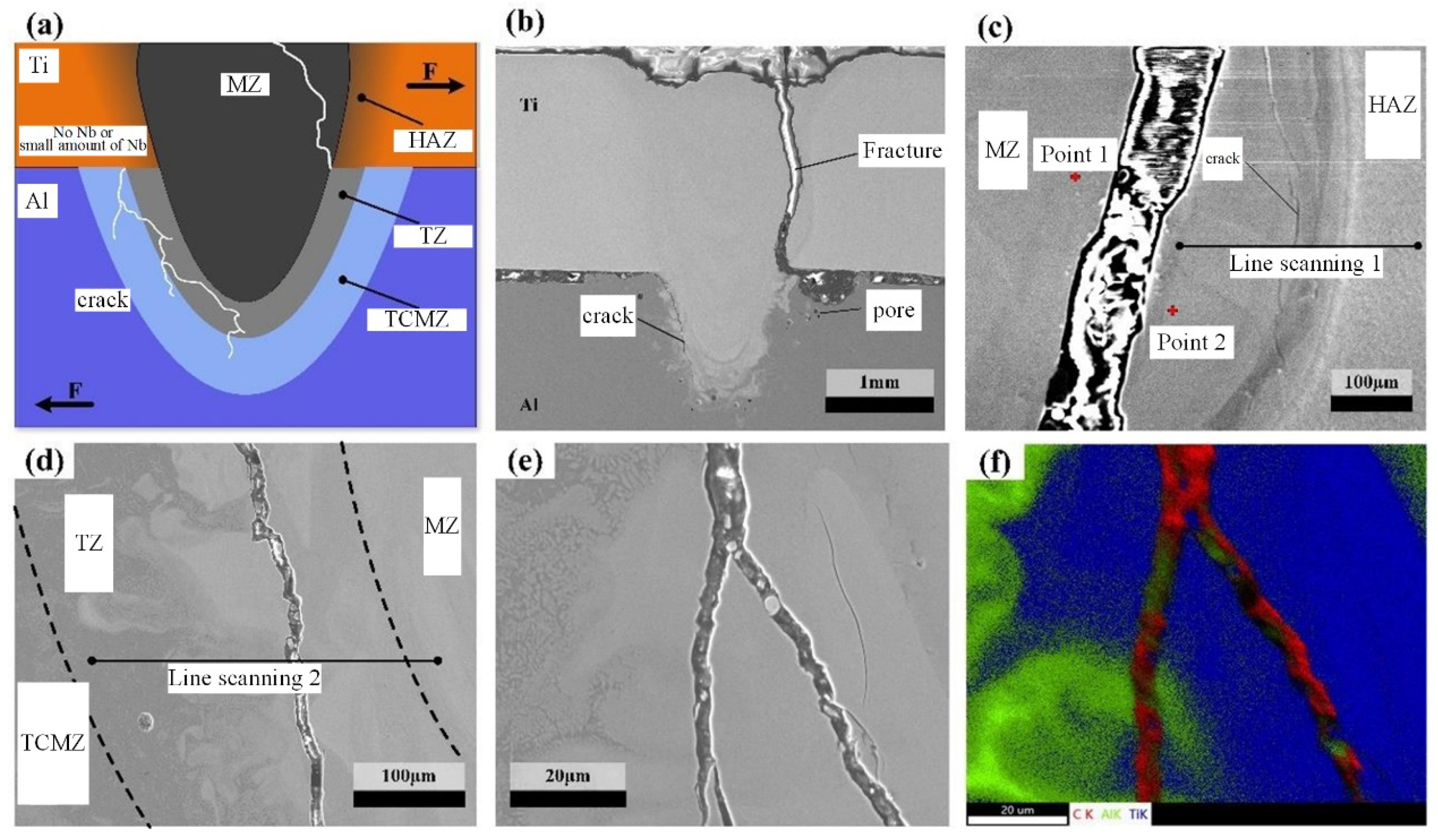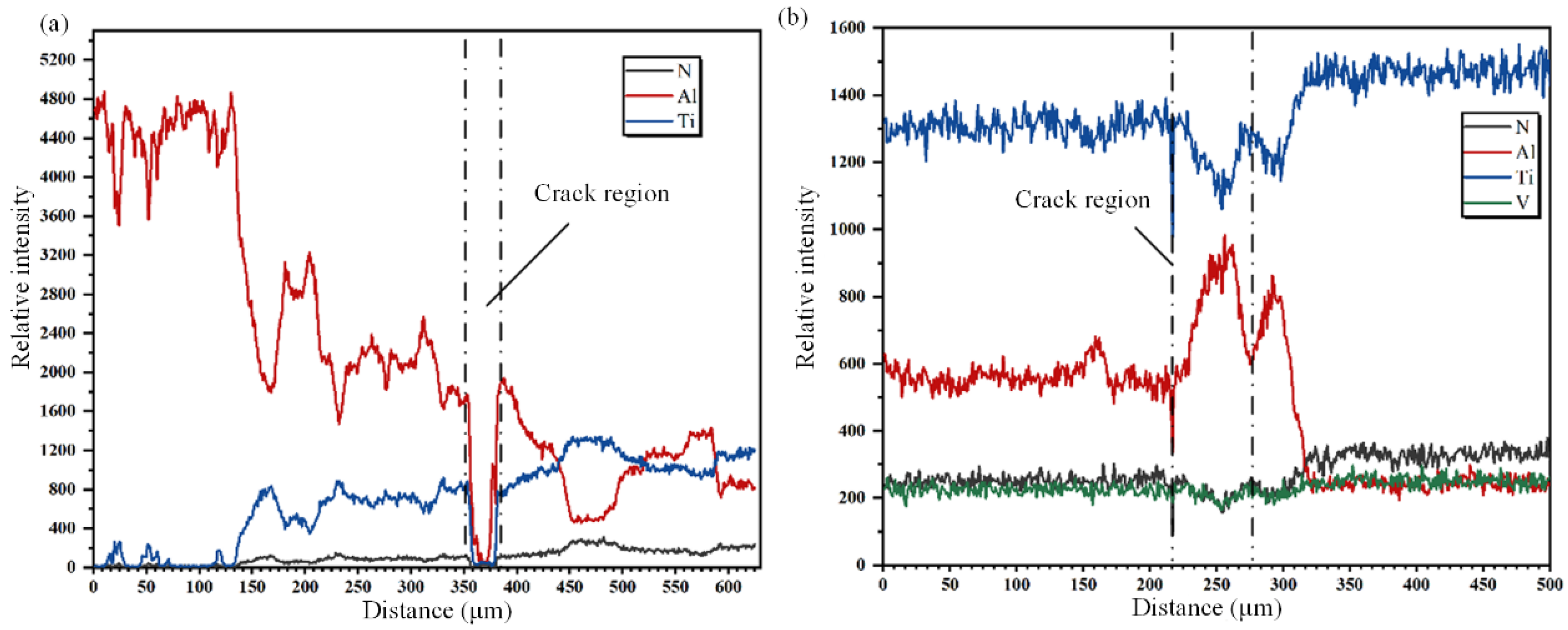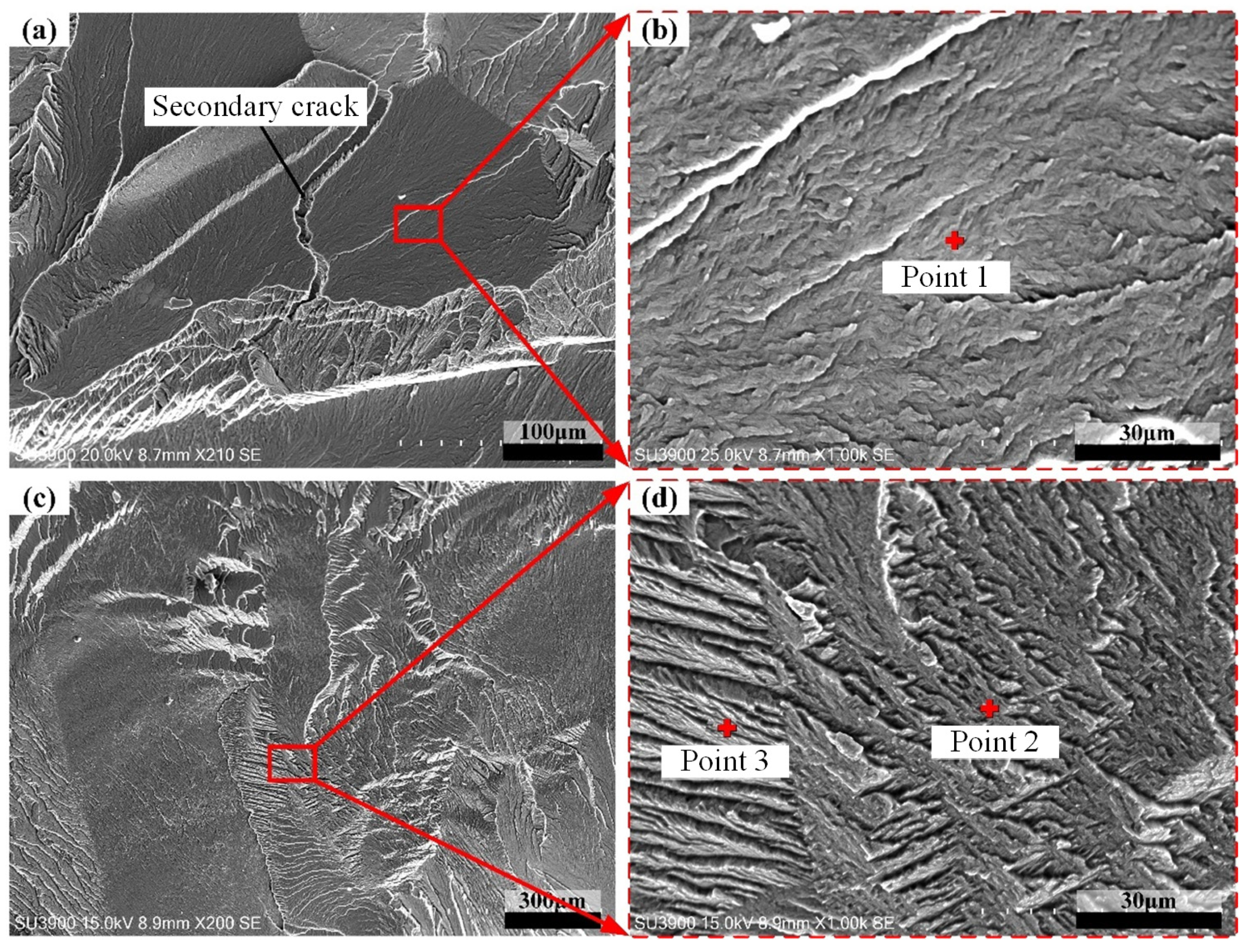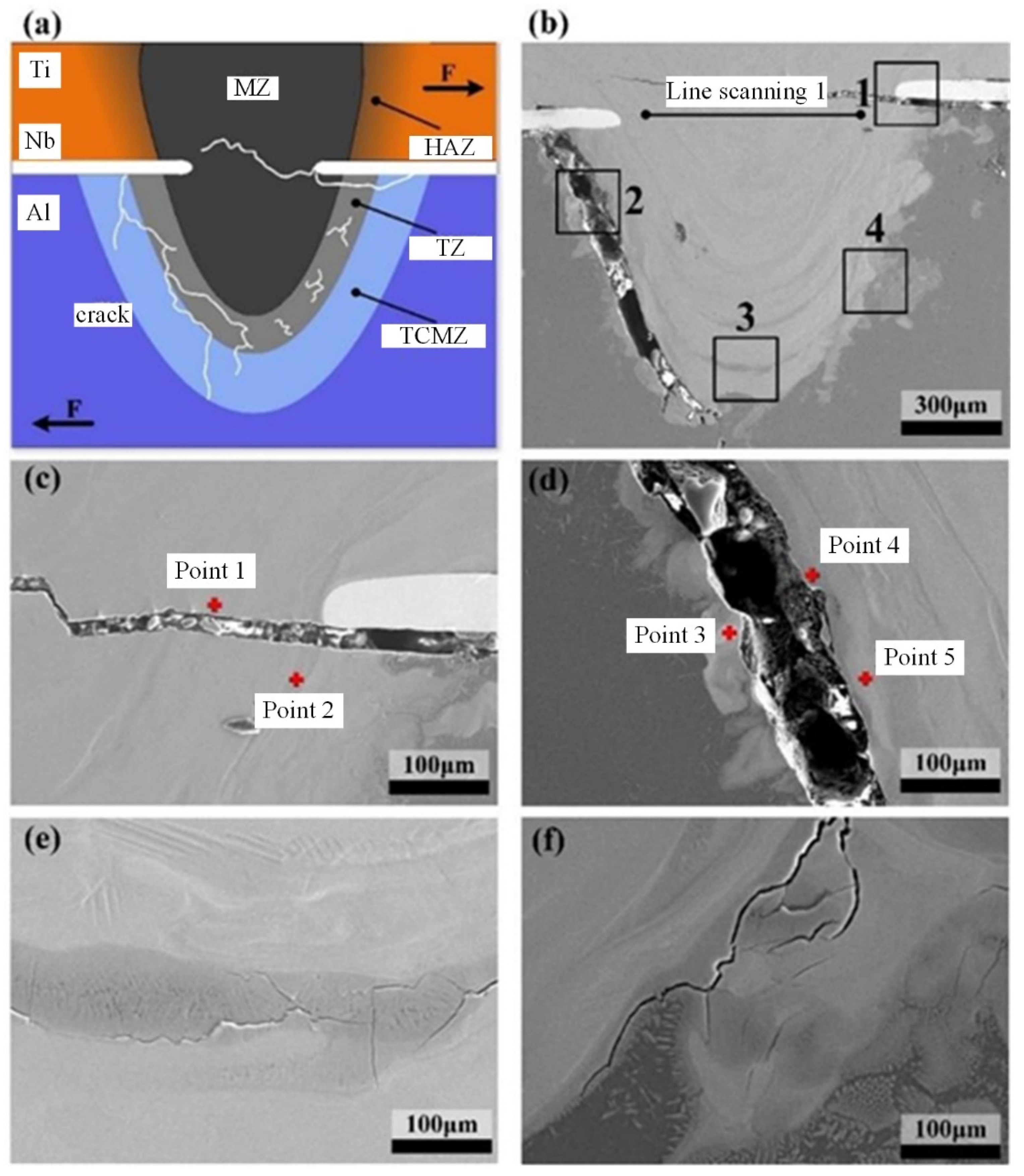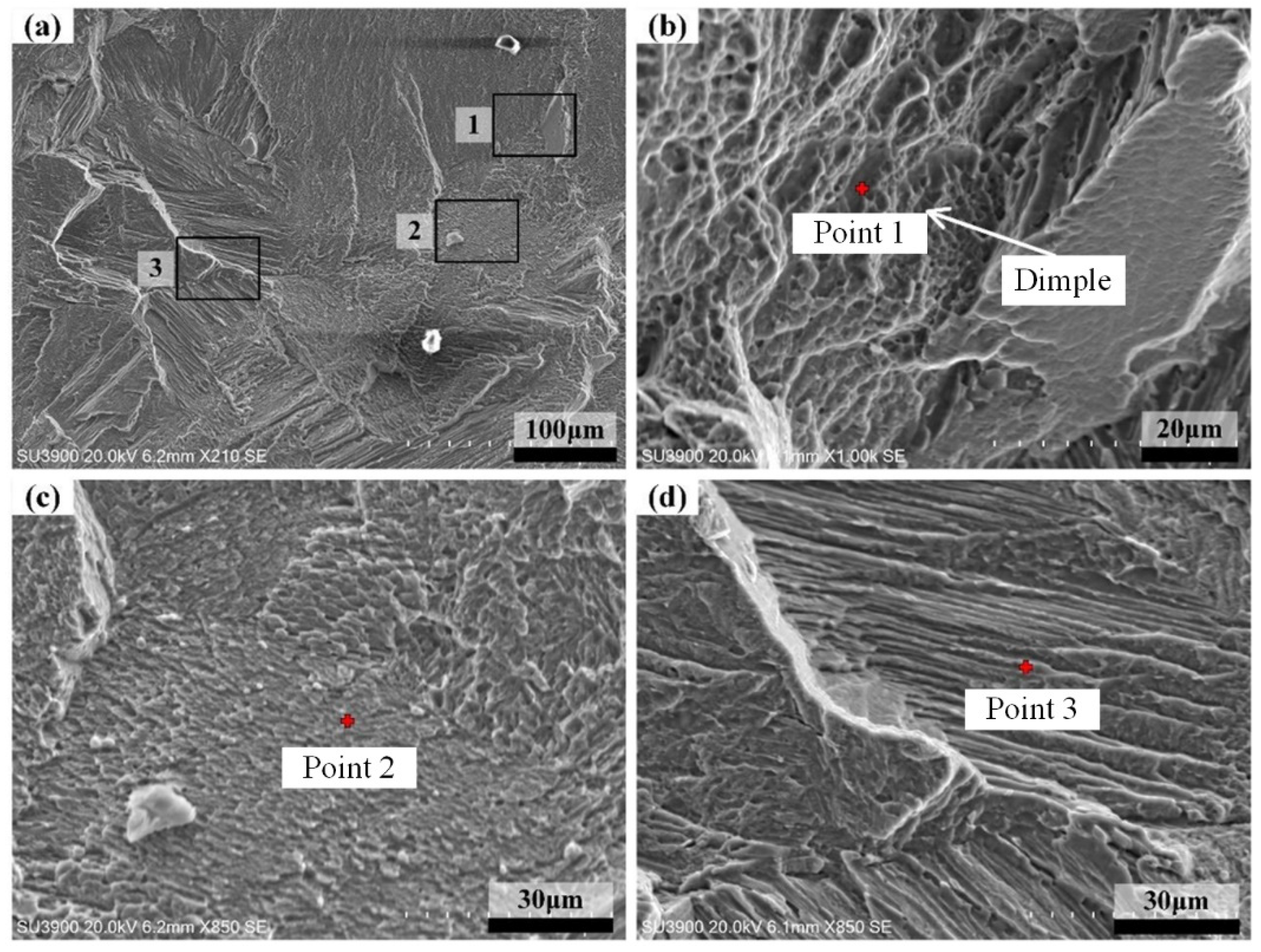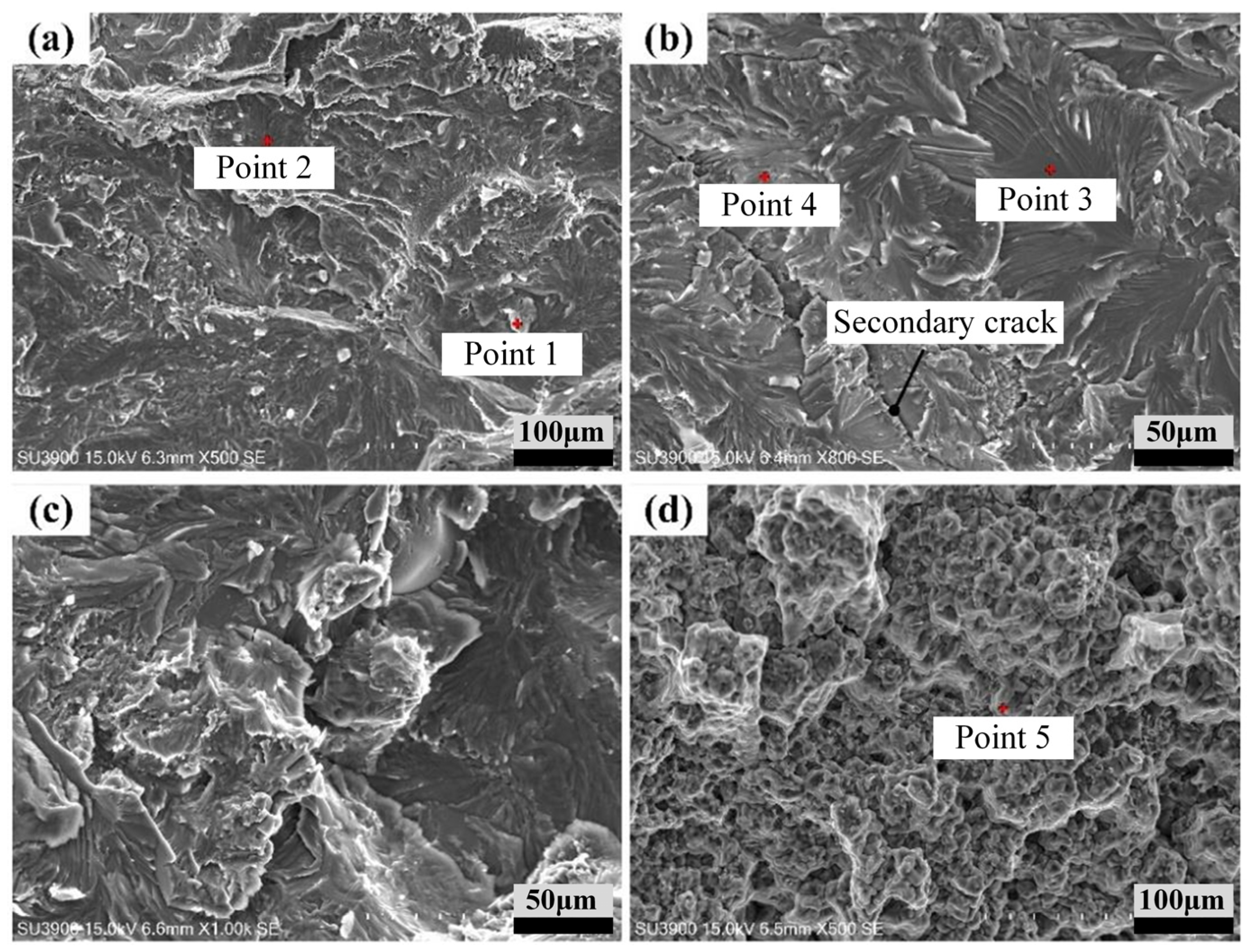3.2. Effect of Nb on Microstructure of Joints
The microstructure of dissimilar metal laser-welded joints consisting of Ti and Al is highly intricate, with the brittle intermetallic compounds of Ti–Al being the deciding factor in the mechanical properties of the joints. Several intermetallic compounds of Ti–Al, such as Ti3Al, Ti2Al, TiAl, TiAl3, etc., can form within the joints during the welding process. The mechanical properties of the joint are greatly influenced by different Ti–Al intermetallic compounds.
Figure 6 presents the welded joint’s bottom profile before and after alloying. Upon comparison, the profile of the welded joint remains consistent before and after alloying. However, the high melting point of Nb results in less melting in the width direction after alloying, causing the melting width at the interface to narrow. Moreover, Nb may absorb a significant amount of energy during the welding process, affecting the fluctuation state of the keyhole. Consequently, there is a difference in the distribution of compounds at the bottom of the welded joint before and after alloying. The joint’s cross-section can be divided into four regions: the mixture zone (MZ), transition zone (TZ), thermal conductivity melting zone (TCMZ), and heat-affected zone (HAZ), as illustrated in
Figure 6(b1,b2), after corrosion with Keller’s reagent. The mixture zone is the region of the Ti–Al intermetallic compounds formed by the mixing and cooling of Ti and Al alloys under the molten pool’s flow field during welding, containing significantly more Ti than Al. The transition zone is the element transition region gradually transitioning from a Ti-rich zone to an Al-rich zone, resulting in relatively more complex intermetallic compounds. The thermal conductivity melting zone is primarily caused by the lower melting point of Al compared to that of Ti–Al intermetallic compounds. After the Ti–Al intermetallic compounds solidify, heat is further transferred to the Al alloy, leading to a larger melting range of the Al alloy. Therefore, almost no Ti–Al intermetallic compounds are produced in this region. The heat-affected zone is the region where heat diffuses along the plate and causes a phase change in the Ti alloy during the welding process. Laser-melted Nb brought into the molten pool may regulate the welded joint’s microstructure, optimizing its mechanical properties.
The TCMZ structure comprises three main types of Al-based structures: distinct columnar + equiaxed crystal zones, fully columnar crystal zones, and columnar + equiaxed crystal mixed zones, as depicted in
Figure 7. These structures are primarily influenced by the welding temperature, melt flow, and chemical element diffusion. As the heat conducts to the Al alloy through the weld seam area during the welding process, the Al alloy absorbs the heat and its melting range continuously expands until the maximum boundary of the melting area is reached. During the cooling process, the temperature near the melting boundary drops, creating temperature conditions for columnar crystal growth. When the temperature falls below the liquidus temperature, the liquid metal near the melting boundary nucleates and grows on the Al matrix grains, indicating that the initial melting boundary is epitaxial growth. However, different grain growth mechanisms beyond the melting boundary lead to varying grain distribution in the TCMZ. Any disturbance in the TCMZ causes Ti to diffuse rapidly to the TCMZ near the TZ, resulting in the formation of granular Ti–Al metal compounds. These compounds, which act as nucleation points for equiaxed crystals, disperse near the weld zone and eventually grow together with columnar crystals, forming the distinct boundary columnar + equiaxed crystal zone shown in
Figure 7a. In contrast, the fully columnar crystal zone in
Figure 7b is the result of competition between the TCMZ grains. During the solidification process of the TCMZ, grains grow along the direction perpendicular to the contour due to the largest temperature gradient perpendicular to the weld seam contour direction, hindering and repelling the growth of unfavorably orientated grains. This results in a relatively stable welding pool without convection, and alloy elements do not diffuse to the TCMZ and TZ. At the bottom of the melting pool, kinetic energy and gravity generated by the fluctuation of small holes in the depth direction accelerate the diffusion and deposition of elements and Ti–Al compound particles to the bottom of the melting pool, causing grain fragmentation. These fragments and heterogeneous particles act as random nucleation points for equiaxed crystals. The area with nucleation points hinders the growth of columnar crystals, while the area without nucleation points forms columnar crystals, as shown in
Figure 7c.
The TZ is the intermediate area where the weld changes from the Ti-rich zone to the Al-rich zone. The internal structure of the TZ is complex and diverse. Due to the significant differences in melting points, thermal conductivity, and thermal expansion coefficients between titanium and aluminum, large welding stresses are generated in this area during the cooling process. These stresses can cause Ti–Al intermetallic compounds to form cracks in the TZ.
Figure 8 shows the low-magnification SEM images of the joint before and after alloying, along with the distribution of the microcracks in the TZ. Microcracks were observed and depicted under high-magnification SEM. After alloying, a significant reduction in the number of microcracks in the TZ was observed. Before alloying, the microcracks were continuously distributed mainly on both sides of the weld zone. After alloying, the microcracks were locally and intermittently distributed mainly near the bottom and interface. The cracks can be characterized by the crack rate
r, which is the ratio of the length of the microcracks to the total length of the transition zone, as shown in
Figure 8. Here,
l represents the total arc length of the transition zone, and
li represents the arc length of the crack zone in the transition zone, as calculated by the Equation (1).
Two sections with different Nb content were randomly selected for crack analysis, and the crack rate was obtained for each Nb content, as shown in
Figure 8(b1,b2). It can be observed that the overall microcrack rate in the transition zone was significantly reduced after alloying, and the crack rate gradually decreased with the increase of Nb content, indicating the significant effect of Nb in inhibiting cracks in the transition zone. Scholars have conducted molecular dynamics simulations to explore the effect of Nb on crack propagation in the TiAl alloy, and it was found that Nb can reduce the relaxation energy and increase the binding energy between TiAl alloy atoms, thereby enhancing their stability. With increasing Nb content, the cohesion between atoms increases and the peak stress value rises. Consequently, when the stress reaches its peak value, the crack begins to propagate slowly, and the stress decreases gradually. This indicates that Nb enhances the ductility of the TiAl alloy [
20].
During the welding process, there are significant changes in the recoil pressure in the depth direction and the violent fluctuation of small holes occurs. Consequently, a small amount of Ti-based melt splashes into the Al-based melt at the bottom of the weld, forming island-shaped Ti–Al intermetallic compounds, as illustrated in
Figure 9(a1,a2). The Ti-based melt splashed from the weld area generates a certain vortex, which results in the sandwiching of Al-based melt between Ti-based melt. This process leads to the formation of complex and diverse Ti–Al intermetallic compounds within the islands. EDS composition analysis of three typical representative areas, by SEM, indicates that the island-shaped Ti–Al compound area has at least three phase compositions. The analysis of Point 1 shows that the Ti–Al intermetallic compound in this area may contain Al
2Ti with the Nb element. Point 2 corresponds to an area that may contain Al
3Ti with the Nb element, while Point 3 corresponds to an area that may contain Ti
2Al with the Nb element. At low magnification, cracks were observed at the bottom of the weld. High magnification observation of the tissue structure and the crack morphology showed differences, as depicted in
Figure 9(a3,a4). The point scan and line scan results suggest that Point 4 corresponds to a coral-like area that may contain Al
3Ti with the Nb element. Point 5 corresponds to a groove-like area that is mainly composed of Al-based tissue, indicating that this structure is not a crack. Point 6 corresponds to a white area that may contain TiAl with the Nb element.
3.3. Effect of Nb on the Mechanical Properties of Joints
Three shear strength tests were conducted on the joints, with varying Nb content, to investigate the impact of Nb content on the joints’ mechanical properties. The experimental results are illustrated in
Figure 10a. As depicted in the figure, the average strength of the Ti/Al joint increases after alloying, and the joint strength reaches its peak (approximately 192 N/mm) when the Nb foil thickness is 0.05 mm. The joint strength is boosted by approximately 25% compared to pre-alloying, indicating that adding Nb as an alloying element to the joint can significantly enhance its strength.
Figure 10b illustrates the shear-force displacement curves under two Nb contents, and no obvious yielding process is observed. The shear force drops sharply after reaching the maximum value, indicating typical brittle fracture characteristics.
For fracture forms in dissimilar welded joints, Fu et al. [
21] studied the hydrogen induced stress corrosion cracking behavior of SUS301L-MT laser-arc hybrid welding joints and found that the cracks mainly formed intergranular cracking, transgranular cleavage, and secondary cracks on the fracture surface. Zhan et al. [
22] studied the ultrasonic welding between AZ31B magnesium alloy and pure copper. It was found that the main component of the interface diffusion layer was Mg
2Cu, and the fracture mode of the joint was an interface type fracture, with a maximum joint strength of 2798 N. Tayyebi et al. [
23] prepared Al/Cu/Mg multilayer composite materials using the accumulative roll welding process and annealed them at different temperatures and times. It was found that the accumulative strain under different annealing conditions had very little effect on the thickness of the intermetallic compounds. In addition, it was determined that the growth mechanism of the Al/Mg intermetallic layer was controlled by diffusion and reaction. In this work, three types of fracture forms were observed during the shear testing process, namely root fracture, lateral fracture, and interface fracture. These fracture forms correspond to distinct fracture processes and morphologies, indicating differences in fracture mechanisms.
Figure 11a depicts the schematic diagram of the side fracture of the joint along the weld zone, and
Figure 11b presents the actual transverse fracture morphology. As illustrated in the figure, the joint crack originates from the intersection of the interface and the weld zone, extends through the entire weld zone, and eventually causes the joint’s failure. Additionally, the transition zone, which is subjected to tensile stress, is highly susceptible to cracks, and cracks can initiate from the interface and propagate towards the bottom of the weld.
Figure 11c provides a local magnification of the fracture position of the weld, revealing multiple microcracks near the main crack propagation path, dispersed in the weld zone near the melting boundary. A line scan of the melting boundary indicates that the chemical composition content near the melting boundary exhibits significant fluctuations, as depicted in
Figure 12. In the weld zone, each chemical element’s content remains stable, while the relative strength of the Ti, N, and V elements significantly decrease in the area between the two microcracks, and the relative strength of the Al element increases significantly, indicating an enrichment of the Al element between the two microcracks. Moving from the MZ to the HAZ, the relative strength of the Ti, N, and V elements significantly increase, surpassing that in the MZ, while the relative strength of the Al element drops sharply and remains steady. EDS composition analysis was carried out on both sides of the fracture position, and
Table 4 shows the results. Points 1 and 2 display comparable chemical compositions and may be Ti
3Al.
Figure 11d provides the local morphology of a crack induced by tensile stress in the weld zone. The Ti–Al intermetallic compound in the TZ is flocculent, primarily due to the solidification of the Ti–Al intermetallic compound in the MZ during the welding process, while the thermal conductivity melting zone stays liquid. Upon cooling, the Ti element diffuses irregularly and forms a flocculent Ti–Al compound.
Figure 12 displays the results of line scanning analysis conducted on the TZ. The figure depicts the changing trend in each element’s relative strength in the TZ, demonstrating that the gradient of the element content change in the TZ is relatively high, resulting in the formation of a complex compound.
Figure 11e,f shows the extension morphology and element distribution map for the transition zone crack, respectively. By comparison, it is evident that the microstructure’s brightness corresponds to the Ti content, and the crack generally propagates along the Ti-rich zone.
Secondary cracks can be observed on the cross-section of the weld seam before alloying, as illustrated in
Figure 13a, using high-magnification SEM. The propagation path of the secondary cracks is flat, indicating brittle fracture characteristics.
Figure 13 displays many irregularly shaped Ti–Al intermetallic compounds distributed on the large cleavage plane with a darker contrast. The atomic fraction for Ti and Al at Point 1 is 53.9% and 15.8%, respectively, indicating that the phase composition is Ti
3Al. Another typical fracture morphology, shown in
Figure 13c, is characterized by a small, stepped shape. The parallel cleavage planes indicate uniform stress and phase distribution in this region during the fracture process. Component testing in the two regions with bright and dark contrast reveals the atomic content of Ti and Al at Point 2 to be 83.9% and 2.1%, respectively, while at Point 3, the atomic content of Ti and Al are 63.5% and 5.4%, respectively. These results indicate that the region is a Ti-based alloy structure.
Figure 14a presents a schematic diagram illustrating the interface fracture process of the joint, while
Figure 14b displays the actual cross-sectional fracture morphology when the joint was alloyed with a 0.05 mm Nb foil. The regions labeled 1, 2, 3, and 4 in
Figure 14b correspond to
Figure 14c–f, respectively. The figure reveals that under tensile stress, the weld seam undergoes macroscopic fracture, whereas it remains effectively connected under compressive stress during the interface fracture process. The microcracks are more sensitive to tensile stress, hence the crack initiation and propagation speed is faster on the tension side. Microcracks also propagate on the compression stress side and at the bottom of the weld seam, as shown in
Figure 14e,f, but these cracks have not yet connected and converged during the expansion process. As the shear force increases, the Nb foil tip embedded in the weld seam interior causes a cutting action, leading to stress concentration at the tip under shear force and crack initiation.
EDS point analysis was performed on Regions 1 and 2 to investigate the composition of the tissues near the crack propagation path. The scan results are presented in
Table 5. In the weld region, the gray area is mainly composed of the TiAl compound, whereas the bright area is mainly composed of the Ti
3Al compound. In the transition region, TiAl
3, TiAl
2, TiAl, and their mixtures are formed from the outside to the inside, in accordance with the compositional change law from the Al-rich to the Ti-rich region. The crack propagates primarily along the TiAl
2 compound, on the side subjected to tensile stress. This may be due to the higher susceptibility of TiAl
2 to microcracks under welding stress, as well as its expansion and connection under shear stress, thereby guiding and accelerating the propagation of the main crack.
Figure 15a shows the typical fracture morphology of the Ti-side interface, where three distinct regions are observed.
Figure 15b displays an enlarged view of Region 1, where numerous small dimples indicate a ductile fracture in that specific region. Point 1 scan analysis reveals an enrichment of Ti atoms (85.3%), along with Al (6.2%), and Nb (1.5%) atoms, enhancing the toughness of the area.
Figure 15c provides a closer look at Region 2, which exhibits a fracture composed of layered Ti–Al intermetallic compounds in a fish-scale shape formed by small, stepped surfaces. Point 2 analysis shows Ti atoms accounting for 63.5%, Al atoms accounting for 19.4%, indicating the possibility of Ti
3Al.
Figure 15d depicts a shear force joint fracture along the interface in Region 3, where winding slip lines form on the fracture surface. Point 3 analysis shows Ti atoms accounting for 64.9%, Al atoms accounting for 30.7%, and Nb atoms accounting for 1.7%, indicating the possibility of Ti
2Al. Therefore, niobium microalloying leads to the joint mainly fracturing in the transition zone and interface, exhibiting brittle and ductile fracture characteristics with obvious cleavage planes, many dimples, and slip lines.
Figure 16a presents a schematic diagram of the root fracture that occurred in the joint, while
Figure 16b shows the actual section fracture morphology under 0.2 mm Nb alloying, with Regions 1, 2, and 3 corresponding to
Figure 16c–e, respectively. Due to the shallow welding depth, the microcracks generated as a result of the stress concentration caused by the difference in hardness between the inside and outside of the transition zone and the cooling process are relatively few. Once the joint is subjected to shear force, the stress concentration near the interface of the aluminum alloy thermal conductivity melting zone and the transition zone on the tensile side cause cracks to occur, first at the interface of the two regions on the surface of the aluminum alloy plate, as depicted in
Figure 16. The Al alloy structure of the thermal conductivity MZ has good toughness and plasticity, leading to low crack sensitivity, while the weld zone structure is dense and hard, with no microcrack generation. Consequently, the crack requires higher energy to propagate along this area, limiting propagation to the TZ, where the propagation resistance is minimal. Secondary cracks in the peripheral Ti–Al intermetallic compounds arise along the propagation path of the primary crack, as shown in
Figure 16c. When the crack emerges from the interface and extends to the bottom of the weld, the tissue near the surface of the Al undergoes greater deformation than the tissue near the lower part, leading to the extension of the crack from the root of the weld to the position with more significant deformation to balance the stress caused by the difference in the deformation of the weld in the depth direction, as demonstrated in
Figure 16d. As the shear force continues to increase, the corresponding TZ subjected to compressive stress produces a growing shear force parallel to the contour, and the crack extends and connects along the contour. Due to the complex structure of the transition zone, the crack propagation process leads to the occurrence of secondary cracks, as depicted in
Figure 16e.
Point analysis was conducted to investigate the tissue composition along the crack propagation path. The scanning points were labeled in the figure, and the scanning results are shown in
Table 6. Based on the analysis results, the grey area marked by Points 3 and 4 mainly consists of Al, indicating that the deformation crack propagates along the melting zone of the aluminum alloy. Compounds corresponding to Points 1 and 2 are possibly TiAl
2 and TiAl, respectively. These indicate that the phase composition of the transition zone is complex, and the phase composition trend is consistent with the law of elemental diffusion. Compounds corresponding to EDS Points 5 and 6 are possibly TiAl and Ti
3Al, respectively. This indicates that the proportion of the Ti element in the phase composition is higher closer to the inside of the weld.
Figure 17a presents a magnified view of the Ti-side fracture surface, revealing clear edges and a mountain-shaped appearance with river-like cleavage steps. The edges of the steps contain white bright spots of varying sizes and shapes, indicating a brittle fracture failure mode in this area. Point analysis identified that the grey area corresponding to Point 2 has a Ti atomic content ratio of 39.6% and an Al atomic content ratio of 48.4%, suggesting the possibility of TiAl phase composition. In contrast, the bright area corresponding to Point 1 has a Ti atomic content ratio of 84.2% and an Al atomic content ratio of 10.1%, indicating the possibility of Ti alloy fragments. This finding suggests that the distribution of intermetallic compound organization is uneven, and the cleavage crack is partially hindered after extending to the Ti alloy organization, causing the crack front to pull and the direction to change, forming a new cleavage surface.
Figure 17b displays a typical cleavage fracture with a regular river pattern, revealing clear secondary cracks with straight paths and brittle fracture characteristics. The dark area corresponding to Point 3 has a Ti atomic content ratio of 39.6% and an Al atomic content ratio of 39.4%, indicating a possible TiAl phase composition and an extension of the cleavage surface along the TiAl phase.
Figure 17c shows a large number of laminated and block-like intermetallic compound accumulations with significant height differences, mainly related to the phase composition and stress state of the transition zone. The more complex the phase composition and stress state, the more intricate the corresponding fracture morphology.
Figure 17d indicates, through Point 5 component analysis, that the vast majority of the atomic ratio is Al, which confirms that the organization in this area is an Al alloy and that the crack did not extend completely along the TZ.
